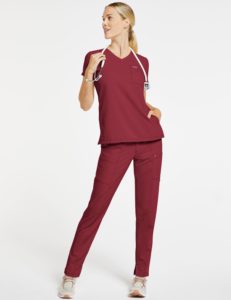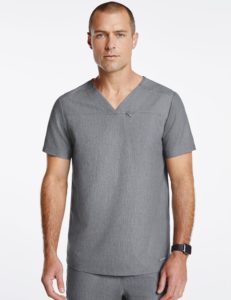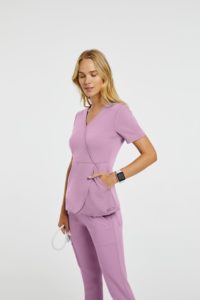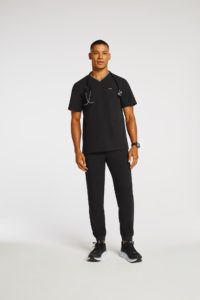
Our 4 Best Fabrics For Medical Scrubs
Hospital scrubs have been a mainstay of medical fashion for quite some time. If you’ve taken even the most cursory glance at a historical drama or picked up a book about World War II, you know that scrub patterns have changed a lot over the past century or two, along with the fabric used to make them.
Before the 20th century, surgeons used to wear black clothes to hide bloodstains. However, these uniforms and their materials were not the scrubs we know today. Later, during the early-20th century, rudimentary scrubs switched to muslin fabric before changing to a mixture of muslin and rubber to make them more moisture-resistant. Unfortunately, as it turns out, this particular blend of material was not the most desirable or efficient thing to wear.
Later, modern scrubs emerged with four fabric types that rose in popularity to meet this challenge: cotton, rayon, spandex and polyester. You could even find nylon scrubs, too. Blends of these main fabrics became popular, and many remain popular today.
But what are the best scrub fabrics, and what should you know about them before buying a pair?
Read on as we dive into the details now.
Fiber fabrics for medical scrubs

Cotton, spandex, rayon and polyester have been popular fabrics in fashion for many years, especially for medical uniforms. But medical scrubs are not built the same way as regular clothes, as they often have higher quality standards to meet. Still, each of these fabrics has some common properties that play out as strengths and weaknesses in a healthcare setting.
Cotton
Cotton is one of the most popular fabrics out there for hospital scrubs, and with good reason. Wonderfully breathable, reliably durable and with the ability to make scrubs comfortable, cotton fabric is a perennial favorite for uniforms of all sorts. However, cotton scrubs lack the stretch of other fibers and fiber blends. It can also shrink a significant amount if thrown in a dryer, and it’s highly susceptible to wrinkles.
That said, blending cotton with other, more durable fibers has become a popular choice for medical scrubs.
Polyester
Polyester is a synthetic fabric made from petroleum, air and water. (Yep, it may sound a bit odd, but it’s true.) Extraordinarily durable and one of the least-shrinkable fabrics around, polyester also holds up well under wear and tear and dries quickly, too.
It’s important to remember that pure polyester blends are sensitive to heat, but when combined with other materials, such as rayon and spandex, like in our FUSEryx™ fabric, it works well, dries quickly and is highly durable.
Spandex
What options exist beyond the two scrub mainstays of cotton and polyester? Well, spandex is known as a “stretch” fabric, and for good reason. A synthetic fiber that shares similarities with polyester, spandex neither shrinks nor loses color in the wash. It has natural antiperspirant capabilities, too, and like the other fabrics on this list, spandex blends have become popular over the years.
Rayon
Finally, rayon takes up a much-vaunted spot on the list for popular scrub fabrics. Unique in the fact that it’s made from a fiber derived from wood pulp, rayon shares traits in common with cotton while being cheaper and more absorbent.
The only downside is that it can wrinkle easily, so it needs a little more upkeep than the other fabrics.
Common fabric blends for medical scrubs

Specific fabric blends are more popular these days, and there’s a good reason for this. In a nutshell, fiber blends give you the best of both worlds when it comes to the strengths of each particular fabric while minimizing their weaknesses. In turn, they make for scrubs that are ideally suited for a healthcare setting.
Some of the most common fiber blends that you can find are:
Polyester-cotton
A typical blend that has been around for a while, poly-cotton is a high quality, comfortable, absorbent combination. It’s far less likely to wrinkle than 100% cotton, making it practical, durable and efficient, too.
While it’s not as breathable as all-cotton, poly-cotton offers some options in that department, making sure to keep scrubs cool, so you don’t sweat up a storm. You can also toss it in the dryer on low or medium heat, which means less upkeep than cotton scrubs.
Polyester-spandex
Poly-spandex is another wildly popular fabric blend. This time around, its acclaim stems from its combination of durability and a stretchy weave. Smooth against the skin and unlikely to wrinkle, polyester-spandex workwear can be tumble-dried on low heat, meaning the fabric is functional and easy to clean.
Additionally, you can find scrubs made in specialty fabric blends, like Jaanuu’s FUSEryx™ and SPINryx™ materials. FUSEryx™ is made from a combination of poly, rayon and spandex, while SPINryx™ combines rayon, nylon and spandex. You can find examples of them in our women’s scrub pants and men’s scrub pants selections.
Weave fabrics for medical scrubs

Of course, we’d be remiss if we didn’t mention a few types of fabric weaves found in the medical uniform department—specifically, poplin, dobby and twill.
Poplin is a weave with a cord-like surface. It’s durable, rarely wrinkles and can be used with a fabric fiber like cotton or a cotton-polyester blend.
Dobby is a double weave that is absorbent and wrinkle resistant because of its texture and thickness.
Lastly, twill is a diagonal, ribbed weave that is durable and heavier compared to other fabrics. Additionally, its ribbed surface helps to prevent wrinkles.
What is the best material for scrubs?

Remember, all these fabrics, fabric blends and fabric weaves have the scrub strengths that allow them to get the job done. Still, their performance ultimately depends on the specific job, environment and even something as simple as the weather.
For example, if you’re looking for:
- The best scrub fabric for summer weather: Go for a cotton-polyester blend, which will give you breathability and durability with moisture-wicking properties. Make sure the mixture is lightweight enough for hot, dry temperatures.
- The best scrub fabric for humid weather: Avoid scrubs with cotton, as cotton doesn’t wick away sweat or cool down as quickly. In short, it’ll leave you feeling uncomfortable and sweaty at work.
- The best scrub fabric for cold weather: Choose heavyweight cotton or a cotton blend, as it’ll retain heat better.
- The best scrubs for surgeries: Choose lightweight cotton that you can discard after one use.
- The best scrubs for protection against fluids and chemicals: Pick a polyester or polyester blend, and make sure the percentage of polyester within that blend is high. The durable, synthetic surface is repellant against absorption and will resist stains and germs. For examples of polyester blends, you can check out Jaanuu’s men’s tops section.
And if you’re looking for more medical uniforms coated with an antimicrobial finish, be sure to take a look at our line of women’s scrub tops, too. May you find the perfect fabric blend for your skin!